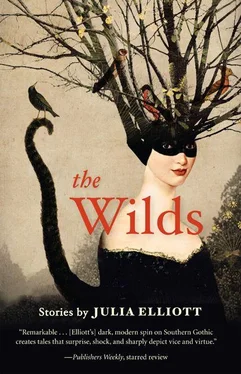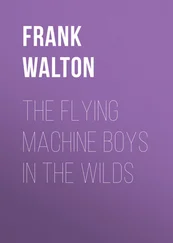If she recalls correctly, 301 is almost a straight shot to the water. Though her legs don’t hurt, her shoulders do, an ache that dips into her bones. Her fingers cramp as they grip the handles of Bob’s chair. And she’s too thirsty to spit. She imagines sweating glasses of sweet tea, cold Coca-Cola in little bottles, lemonade with hunks of fruit floating in the pitcher. She remembers the time she took Bob to meet her grandmother. They drank from a pump on the old wraparound porch, drawing cool springwater up from the earth. She recalls sipping from the garden hose and tasting rubber. Remembers the special flavor of Bob’s musty canteen, the one they always took camping. She and Bob once hiked up Looking Glass Rock, crouched under a waterfall with their mouths open, taking giant gulps, the whole mountain wet with dew. Hosts of tiny frogs clung to the stone, suckers on their toes.
When they get to the lake Elise will roll Bob to the end of their old pier. It’ll be dusk by then, she thinks, catfish crowding in the shallows. She wants him to see water on every side when he wakes up, vast and black, with the sky in pink turmoil, as though it’s just the two of them, out there floating in a little boat.
That autumn a pack of feral dogs swept into our school yard, barking and keening and charging the air with an electrifying stench — wild festering creatures, some bald with mange, others buried in clumps of matted frizz, or hobbling on three legs, or squinting through worm-eaten eyes. Rip Driggers was on the porch of my portable, cooling off after a laughing fit, and he came scrambling through the door, waving his fists and spitting, “Dogs, dogs, dogs, hundreds of ’em — craziest mutts you ever saw.” We were into the sluggish haze of afternoon, picking at a Dickinson poem, the room smelling of sour socks. My dozing seventh-graders dashed from their seats to the windows. The dogs were their salvation, mongrel hordes pouring in from strange, magic parts of the earth.
The animals skittered around the playground, yapping at each other, squirting piss onto swing sets, sniffing each other’s piss, pissing on each other’s piss, snorting at each other’s anuses, and snarling. They threw themselves into tangles of squealing and flew apart again.
The principal emerged from the cafeteria, peered at the dogs, and then hurried back inside. A minute later his nasal drone issued from the PA system: “A collection of stray canines has entered our playground area. Teachers and students must not leave the main building or their portable classrooms. Please check to make sure all doors are closed and locked.”
I stood at a window watching the wild beasts prance in the sun.
In less than fifteen minutes a fleet of SUVs glittered in the school’s front drive. Mothers sat idling, but no one could leave the school yet, even though the dogs had moved down to the soccer field, even though the ASPCA, the Humane Society, the police and fire departments had all been called, even though the soul-stirring, apocalyptic wails of multiple sirens announced that authority figures were speeding nigh.

Suddenly I’d found myself past thirty, shacked up with a fussy bald man nine years my senior who enjoyed monitoring every facet of our household — finances, thermostat, hot-water heater, water and electricity usage, lawn maintenance, and pest control. His brain had become a grid of interlocking systems. His eyes were shrinking into beads as the years went by — he who had once been a luminescent lover, a beautiful, pale trembler with long, flowing hair. I didn’t know how this had happened. But now he sat by our sliding glass door, clutching his Beeman air rifle, some of his old pluck surging back as he scanned the yard for curs.
“The bastards,” as he called them, had chewed our plastic garbage cans to shreds, had consumed every edible morsel in our trash, had strewn the remaining filth far and wide. The hunger-crazed beasts came in the night and gobbled up anything vaguely organic — sprouting potatoes, blood-smeared butcher paper, old leather slippers — and then they puked; they ate their own warm puke; they ran in crazy circles, pausing to deposit steaming mounds of crap onto our green lawn — usually a masterpiece of emptiness now polka-dotted with yellow nitrogen stains.
The previous week the dogs had sprayed our garage with their spicy pee and sent my husband into a tizzy. He removed every object, pressure-washed the area with bleach water, and then slathered key spots with Get Serious! pet odor and pheromone extractor. At night he slid his recliner close to the sliding glass door to keep his vigils. While consuming exactly three Budweisers, he’d brood in the dark with his gun, waiting for that moment when the brutes would come whirling into his floodlit territory, rearranging the molecules of air with their yipping and fried-egg stink. BB pellets did not kill the dogs, who did not seem to remember from one night to the next that they’d been shot, but the yelp of a struck dog made my husband smile. And he, a passionate advocate for gun control, kept threatening to buy himself a serious firearm.
I watched TV alone. Each night the news spouted facts about dog packs. Feral dogs, fast becoming a worldwide menace, dwelled in condemned buildings, junk-car lots, sewers, and abandoned strip malls. They invaded human territory to scavenge and hunt. They killed in teams, herding livestock, cats, and rodents into corners, where they tore them into bite-sized chunks. The American pet craze had led to an epidemic of abandoned dogs. A rash of dog-fighting rings had flared in rural ghettos. And the repressed wolfish instincts of domestic dogs had been coaxed out, had transmogrified into weird new breeds.
The fighting champions of packs naturally ruled over the ex-pets, also over the bait dogs — smaller, wimpier dogs once bred to rile the fighters. You could recognize a bait dog by its shabby condition, its downtrodden vibe and crippled state: etched with scars, half-blind, riddled with abscesses and often lacking a limb, it slunk and whined around the glorious, snapping fighters — sinewy beasts with bear claws and yellow shark teeth. Some of the more splendid alphas had long incisors like baboons’. Others had needle claws that retracted into their toe pads like those of cats. Legions of freakish specialists had stepped out of the woodwork to describe these evolutionary quirks of reverted dog species, and they, along with innumerable dog-bite victims, bewildered farmers, and owners of dismembered cats, were always being interviewed on TV.
My favorite dog specialist was an evolutionary ecologist who’d written his dissertation on the mating habits of wild primates that had forgone foraging to scavenge human food. He’d made his mark with a documentary on a troop of hamadryas baboons who spent their days picking through the rubble of a Saudi garbage dump. And now, back in the States, Dr. Vilkas had become interested in what he called “de-domestication.” He wore army fatigues. He shot his own footage with a digital Minicam. Half artist, half scientist, he looked a little wild himself, peering through unkempt black hair with an unnerving set of mismatched eyes — one blue, one green. Though an American citizen, Dr. Vilkas had a trace of an accent, trilling and growling, and the way he pronounced his z ’s made me blush.
He sported bite-proof arm and leg bands and drenched himself with special pheromones to keep his beloved dogs from attacking him. He skulked among them, filmed them eating and coupling and suckling their scraggly young, filmed them squealing in the throes of birth and barking with joy as they sabotaged a dumpster or disemboweled a rat.
Читать дальше













